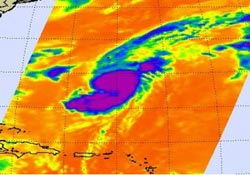NASA sees Tropical Storm Gabrielle resurrected in the Atlantic, Global Hawk to investigate

NASA's Aqua satellite passed over the resurrected Tropical Storm Gabrielle on Sept. 10 at 0559 UTC/1:59 a.m. EDT and detected cloud-top temperatures of powerful thunderstorms (purple) that were colder than -63F/-52C.<br><br>Credit: NASA JPL/Ed Olsen<br>
NASA's Aqua satellite passed over the resurrected Tropical Storm Gabrielle on Sept. 10 at 0559 UTC/1:59 a.m. EDT, hours before it regained strength as a tropical storm. The Atmospheric Infrared Sounder or AIRS instrument aboard Aqua detected cloud-top temperatures of powerful thunderstorms that were colder than -63F/-52C. Cloud tops that extend that high into the troposphere indicate strong uplift in the storm, and are indicative of the potential for heavy rainfall.
After NASA's Aqua satellite passed overhead, NASA sent out an unmanned aircraft from the Hurricane and Severe Storms Sentinel or HS3 mission. HS3 features NASA's two remotely piloted Global Hawks. During the mission, both aircraft are being flown remotely from the HS3 mission base at NASA's Wallops Flight Facility in Wallops Island, Va. At 9:58 a.m. EDT today, Sept. 10, NASA's Global Hawk 871 took off to begin HS3 Science Flight number 7 to fly into Tropical Storm Gabrielle.
Another satellite was used to provide a look at the redevelopment of Gabrielle. NASA's GOES Project at the NASA Goddard Space Flight Center in Greenbelt, Md. created a 27 second video animation of imagery from NOAA's GOES-East satellite from Sept. 8 to 10 that shows Tropical Storm Gabrielle's resurrection. In the GOES satellite imagery, most of the clouds and showers are northeast of the center of circulation.
At 11 a.m. EDT/1500 UTC Gabrielle had maximum sustained winds are near 40 mph/65 kph and some strengthening is forecast during the next 48 hours, according to the National Hurricane Center. Gabrielle was located near latitude 30.6 north and longitude 65.0 west, about 120 miles/190 km south of Bermuda. Gabrielle is moving toward the north near 12 mph/19 kph and is expected to continue in that direction through tonight before turning northwest and slowing down. The National Hurricane Center noted that Gabrielle is expected to pass over or near Bermuda tonight and early Wednesday, Sept. 11.
At 11 a.m. EDT, sustained winds in Bermuda were from the southwest at 13 mph and are expected to pick up as Gabrielle comes closer. A tropical storm warning is in effect for Bermuda. According to the NHC, Gabrielle is expected to produce rainfall amounts of 3 to 5 inches over Bermuda with isolated maximum totals of 7 inches possible. Bermuda can expect storm surge of 2 to 3 feet above normal tide levels, and tropical-storm-force winds are expected to begin there tonight.
For more information about NASA's HS3 Hurricane Mission, visit: http://www.nasa.gov/HS3
Media Contact
More Information:
http://www.nasa.govAll latest news from the category: Earth Sciences
Earth Sciences (also referred to as Geosciences), which deals with basic issues surrounding our planet, plays a vital role in the area of energy and raw materials supply.
Earth Sciences comprises subjects such as geology, geography, geological informatics, paleontology, mineralogy, petrography, crystallography, geophysics, geodesy, glaciology, cartography, photogrammetry, meteorology and seismology, early-warning systems, earthquake research and polar research.
Newest articles

“Nanostitches” enable lighter and tougher composite materials
In research that may lead to next-generation airplanes and spacecraft, MIT engineers used carbon nanotubes to prevent cracking in multilayered composites. To save on fuel and reduce aircraft emissions, engineers…

Trash to treasure
Researchers turn metal waste into catalyst for hydrogen. Scientists have found a way to transform metal waste into a highly efficient catalyst to make hydrogen from water, a discovery that…

Real-time detection of infectious disease viruses
… by searching for molecular fingerprinting. A research team consisting of Professor Kyoung-Duck Park and Taeyoung Moon and Huitae Joo, PhD candidates, from the Department of Physics at Pohang University…




















